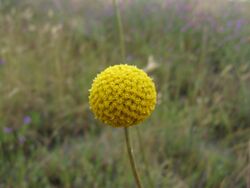Biology:Pycnosorus
| Pycnosorus | |
|---|---|

| |
| Pycnosorus globosus | |
| Scientific classification Error creating thumbnail: Unable to save thumbnail to destination
| |
| Kingdom: | Plantae |
| Clade: | Tracheophytes |
| Clade: | Angiosperms |
| Clade: | Eudicots |
| Clade: | Asterids |
| Order: | Asterales |
| Family: | Asteraceae |
| Subfamily: | Asteroideae |
| Tribe: | Gnaphalieae |
| Genus: | Pycnosorus Benth.[1] |
Pycnosorus is a genus of six species of plants in the family Asteraceae. Commonly known as billy buttons or drumsticks, they are annual or perennial herbs or small shrubs with a cylindrical to spherical head of up to 200 daisy-like "flowers". Each "flower" is a pseudanthium consisting of between three and eight florets surrounded by bracts. The petals are joined to form a small tube and the florets with their surrounding bracts are yellow or golden-yellow.
Description
Plants in the genus Pycnosorus are annual or perennial herbs, with leaves decreasing in size up the stem, those at the base withering first. The flowers are arranged in oval to more or less spherical heads of 40 to 200 flower-like partial heads. Each partial head consists of three to eight small flower-like "florets". The florets and the bracts which surround them are yellow or golden in colour. Each flower has five petals joined to form a tube. After pollination the flowers become silky achenes with a ring of feathery bristles.[2][3]
Plants in the closely related genus Craspedia are also known by the common name "billy buttons" but have their flowers on small stalks rather than attached directly to the receptacle ("sessile") as in Pycnosorus.[4][2] There is some evidence that the two genera may in fact be monophyletic.[5]
Taxonomy and naming
The genus was first formally described in 1837 by George Bentham and the description was published in Enumeratio plantarum quas in Novae Hollandiæ ora austro-occidentali ad fluvium Cygnorum et in sinu Regis Georgii collegit Carolus Liber Baro de Hügel.[6] Bentham nominated Pycnosorus globosus as the type species.[7] The genus name (Pycnosaurus) is derived from the Ancient Greek words pyknos meaning "dense" or "thick" [8]:644 and soros meaning "heap".[8]:728
The following is a list of species of Pycnosorus accepted by the Australian Plant Census as at 30 November 2019:
Distribution and habitat
All six species of Pycnosorus are endemic to Australia and there are species in all states except Tasmania. Most species grow in heavy, often rocky soils.[2]
References
- ↑ "Pycnosorus". Australian Plant Census. https://biodiversity.org.au/nsl/services/apc-format/display/60927. Retrieved 10 December 2019.
- ↑ 2.0 2.1 2.2 Doust, Andrew N.; Everett, Joy. "Pycnosorus". Royal Botanic Garden Sydney. http://plantnet.rbgsyd.nsw.gov.au/cgi-bin/NSWfl.pl?page=nswfl&showsyn=&dist=&constat=&lvl=gn&name=Pycnosorus. Retrieved 27 October 2018.
- ↑ Everett, Joy; Doust, Andrew (1992). "New species and a new combination in Pycnosorus (Asteraceae:Gnaphalieae)". Telopea 5 (1): 39–43. doi:10.7751/telopea19924959. http://plantnet.rbgsyd.nsw.gov.au/emuwebnswlive/objects/common/webmedia.php?irn=75646&reftable=ebibliography. Retrieved 27 October 2018.
- ↑ Everett, Joy; Doust, Andrew N.. "Genus Craspedia". http://plantnet.rbgsyd.nsw.gov.au/cgi-bin/NSWfl.pl?page=nswfl&showsyn=&dist=&constat=&lvl=gn&name=Craspedia. Retrieved 14 February 2019.
- ↑ Schmidt-Lebuhn, Alexander N. (2013). "Reciprocal monophyly of Craspedia and Pycnosorus (Asteraceae, Gnaphalieae) and the problems of using ribosomal DNA at the lowest taxonomic levels". Australian Systematic Botany 26 (3): 233. doi:10.1071/SB13018.
- ↑ Tropicos, Pycnosorus Benth.
- ↑ George Bentham (1837). Stephen Endlicher. ed. Enumeratio plantarum quas in Novae Hollandiae ora austro-occidentali ad fluvium Cygnorum et in Sinu Regis Georgii collegit Carolus liber baro de Hügel. London. https://babel.hathitrust.org/cgi/pt?id=chi.64405481;view=1up;seq=73. Retrieved 17 November 2017.
- ↑ 8.0 8.1 Brown, Roland Wilbur (1956). The Composition of Scientific Words. Washington, D.C.: Smithsonian Institution Press.
Wikidata ☰ Q11701425 entry
 |

